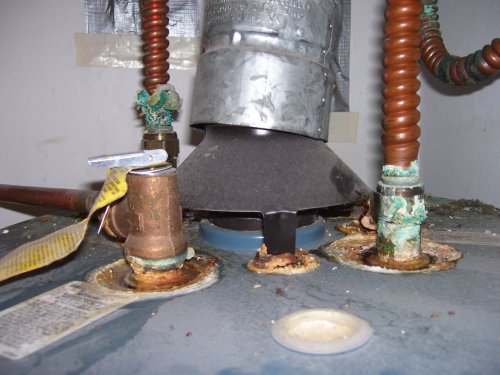In this presentation, Gary Klein shares important information about air source heat pump water heaters (HPWH), with particular attention paid to where the warm air comes ...
How to Keep Your Water Heater From Becoming a Legal Nightmare

To some, water heaters are as mysterious as a black hole. That black hole sucks in nearly six million heaters (from the United States) each year as people endure the cycle of installing a new tank, forgetting it, having it leak, and replacing it. However, ignoring water heaters can be more than a costly annoyance. Their neglect can result in personal injury, property damage, and worse. Take heed, or you could end up in very hot water indeed.
Water heaters are versatile: They can leak, explode, make scalding water, produce poisonous carbon monoxide gas, and cause fires. Fortunately, it's within your power to avoid these problems if you learn a little about water heaters and how to manage them.
Prevent explosions
All tanks must be equipped with a new temperature and pressure (T&P) relief valve when installed. The purpose of the T&P is to protect the tank from excessive pressure and prevent it from ever reaching the boiling point. If a tank heated above 212 degrees ruptures, it will explode with amazing power: a 40-gallon heater can level a house.
Avoid the possibility of an explosion by making sure the heater's T&P valve is functioning. (They can clog and be unable to release water.) Test the relief valve at least yearly. Lift the test lever and allow it to snap back down. If little or no water runs while it's open or if it leaks after you close it, replace it. (In our hard-water area, about a quarter of the valves fail this test.) It may be an annoyance to replace relief valves, but that's nothing compared to the potential for problems caused by not replacing them.
Check also to be sure the drain line is piped from the T&P to a safe location. Otherwise, someone could get sprayed with boiling water while the valve is doing its job.
Avoid fires and scalding
Does the tank have a blanket on it? Blankets save energy, but they also cover up safety stickers. You may hope tenants use good sense, but it helps to teach them as much about safety as possible. The Gas Appliance Manufacturers Association (GAMA) has free safety stickers and other information covering fire and scald prevention. Call them at 1-800-GAMA-811. Put stickers on older tanks or those with blankets.
Risk of serious scalding is greatest while bathing or showering. In recent years, utility companies and others have recommended lowering tank temperature to 120 degrees. This setting is fine if users are in good health. However, if users are very old, very young, ill, or have immune-system problems, the scald risk must be balanced with bacterial risk. A minimum of 130 degrees is needed to control dangerous bacteria (such as that which causes Legionnaires' disease). Use a candy or meat thermometer at the tap to measure actual water temperature. You can install anti-scald shower valves to lower the risk, also.
Fire becomes a danger when water heaters are used for storage. People pile boxes and other burnable objects on top of the tank around the vent, and they store brooms up close to the combustion chamber. Flammable liquids are often close by. When you visit a property, check the water heater area. Be sure tenants understand the fire danger inherent in improper storage. Consider a line in your rental agreement discouraging use of the water heater as a storage shelf.
Eliminate carbon monoxide danger.
On fuel-fired heaters, blankets can slip and prevent adequate combustion air from getting to the burner, or they can interfere with drafting. This results in poor combustion and can produce carbon monoxide. Poor air supply can cause a back draft. Look for evidence such as soot around the combustion chamber door or rusting at the draft hood on top of the tank. Carbon monoxide can also get into the house if a heater's vent is not correctly hooked up or if it's corroded through. A carbon monoxide detector may help in finding problems. Use qualified help to deal with carbon monoxide problems.
Protect against water damage
If all the priceless antiques someone stores in the garage gets soaked by a leaky heater, you are in for some unpleasantness. If any heaters are in a location where leaking could possibly cause damage, put a drain pan under them. Be sure the pan has a working drain line. (Did you know water heaters can be maintained so that your risk of a leaky heater is next to nothing?)
Water damage can result from heaters that are toppled during an earthquake. Earthquakes are a hazard in much of the world, and in the United States, 38 states have land in active seismic zones. However, the real risk from heaters that have come loose during an earthquake comes from the broken gas line or the mixture of 240 volts and water. You should be aware that the old earthquake strap of plumber's tape nailed into sheet-rock (and maybe wood) is not adequate. It provides a false sense of security. Call the California Seismic Safety Commission at 916-322-4917 and get current information.
Take precautions to make the water heaters you're responsible for as safe as possible. Let the property owners and tenants know what to do (or not do) and why. Keep records of your efforts. Your clients will be better served, your own risk will be reduced, and you won't feel compelled to learn a bunch of lawyer jokes.
Like to learn more?
(Get a copy of Larry and Suzanne Weingarten's Water Heater Workbook in our Store. It's about the best we've ever seen on the subject. And it's a joy to read)
Leave a comment
Related Posts

In this all-technical three-hour seminar, Dan Holohan will give you a Liberal Arts education in those Classic Hydronics systems. He’ll have you seeing inside the pipes as...
We always have turkey for Thanksgiving. I mean who doesn’t? My job wasn’t to cook it, though; it was to eat it.